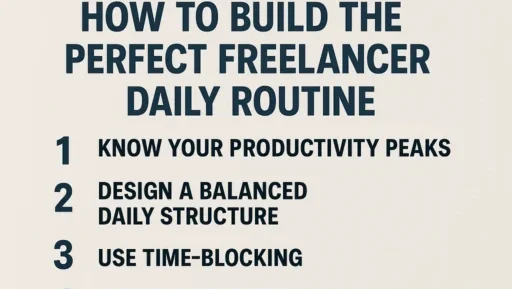One of the biggest challenges freelancers face is creating and maintaining a daily routine that supports productivity, well-being, and a sustainable work-life balance. Without a boss, set office hours, or coworkers, freelancers have full control of their time—but also full responsibility.
A solid daily routine doesn’t just help you get work done—it helps you stay healthy, motivated, and in control. In this article, you’ll learn how to design a daily routine that works specifically for freelancers.
Why Routines Matter for Freelancers
When you don’t have a traditional job structure, time can easily become chaotic. You might:
- Sleep in too late and work late into the night
- Work too much without breaks
- Forget to eat meals or exercise
- Procrastinate and then rush to meet deadlines
A personalized daily routine brings:
- Structure without restriction
- Focus and improved productivity
- Work-life balance and reduced burnout
- Consistent results for clients and yourself
Now let’s build your ideal day.
Step 1: Know Your Productivity Peaks
Everyone has times of day when they feel more focused and energized. These are your productivity peaks, and it’s best to schedule deep work during them.
Common Types:
- Morning person: Peak productivity early in the day
- Afternoon warrior: Energy and focus kick in after lunch
- Night owl: Most creative and active late at night
Track your energy and focus for a few days to identify your natural rhythm, then build your schedule around it.
Step 2: Design a Balanced Daily Structure
Here’s a sample structure you can adapt to your needs:
Morning: Focus and Preparation
- Wake up at a consistent time
- Quick morning routine (stretching, water, coffee/tea)
- Review your goals for the day
- Begin your deep work session (2–3 hours)
Midday: Recharge and Shift
- Lunch and short walk/stretch
- Handle communication (emails, messages, meetings)
- Light tasks (invoicing, updates, client check-ins)
Afternoon: Second Productivity Block
- Continue with project work or second deep work session
- Finish outstanding tasks
- Plan tomorrow’s schedule
Evening: Disconnect and Recharge
- Wrap up and close work apps
- Exercise or engage in hobbies
- Light reading or screen-free time before bed
Step 3: Use Time-Blocking
Time-blocking is a method where you divide your day into blocks of time dedicated to specific tasks. It helps reduce distractions and boosts focus.
Example:
- 8:30–9:00 AM → Morning routine
- 9:00–12:00 PM → Project work (deep focus)
- 12:00–1:00 PM → Lunch and break
- 1:00–2:00 PM → Client emails and calls
- 2:00–4:00 PM → Design or writing tasks
- 4:00–4:30 PM → Admin, scheduling
- 4:30–5:00 PM → Plan next day
Adjust the blocks based on your client deadlines and energy levels.
Step 4: Schedule Breaks
Freelancers often forget to pause. But breaks improve focus, creativity, and mental health.
Try the Pomodoro Technique:
- Work for 25 minutes
- Take a 5-minute break
- After 4 sessions, take a longer 15–30 minute break
Use tools like TomatoTimer or Focus Booster to stay on track.
Step 5: Build Consistency—But Stay Flexible
One of the benefits of freelancing is freedom. Your routine doesn’t have to be rigid—it just needs to serve your goals.
Tips to balance routine and flexibility:
- Create a “core routine” you follow 4–5 days a week
- Leave one day flexible for errands or personal projects
- Batch similar tasks to avoid constant context switching
- Set start and end times for work to maintain boundaries
Step 6: Prioritize Self-Care and Health
Your brain is your biggest asset as a freelancer. Keep it sharp with healthy habits:
- Drink water throughout the day
- Eat balanced meals at regular times
- Exercise 3–5 times per week (even short walks help)
- Limit caffeine late in the day
- Get 7–9 hours of quality sleep
Don’t treat self-care as optional—it’s part of the job.
Step 7: End the Day with Reflection
End-of-day routines are powerful. They help you disconnect, sleep better, and start fresh tomorrow.
Try:
- Reviewing what you accomplished
- Listing three wins from the day
- Writing your to-do list for tomorrow
- Tidying your desk to signal the end of work
This mental “shut down” habit helps create real separation between work and personal time.
Tips from Successful Freelancers
Here’s what high-performing freelancers say about their daily routines:
🟢 “I plan my day the night before. I sleep better and waste less time in the morning.”
🟢 “I treat self-imposed deadlines as seriously as client ones.”
🟢 “Batching tasks like emails, editing, and outreach changed everything for me.”
🟢 “I built a habit of logging off at 6PM no matter what. It made me more efficient during the day.”
A routine doesn’t have to look impressive it just has to work for you.
Final Thoughts: Your Routine Is Your Foundation
As a freelancer, your time is your most valuable resource. A solid routine gives you control, stability, and peace of mind. It transforms chaos into clarity, stress into confidence, and scattered hours into focused achievement.
You’re not just building a routine—you’re building a lifestyle. One that supports your income, health, and long-term success.
Start simple, track what works, and evolve as you go. The perfect routine is the one you can sustain.

